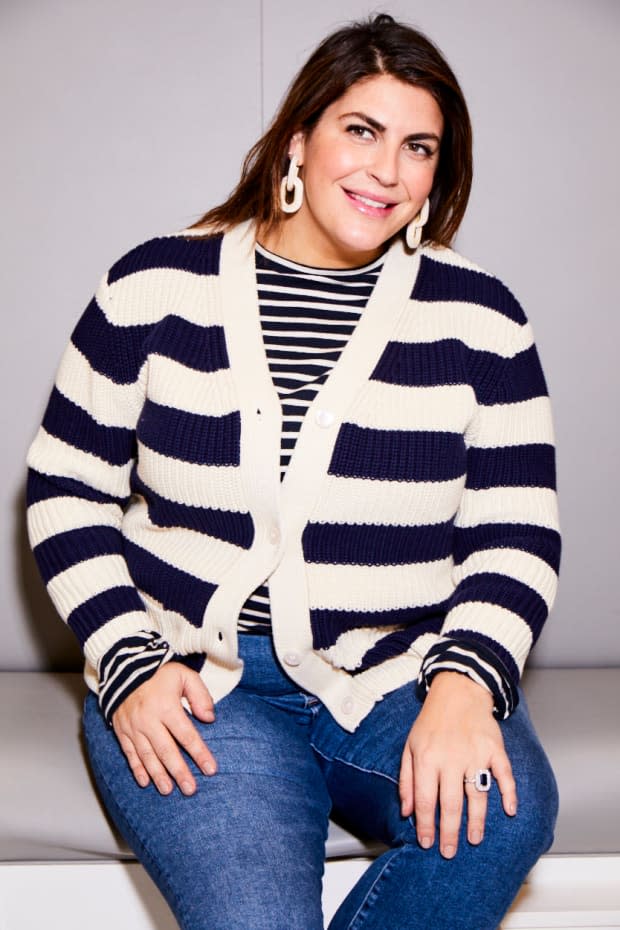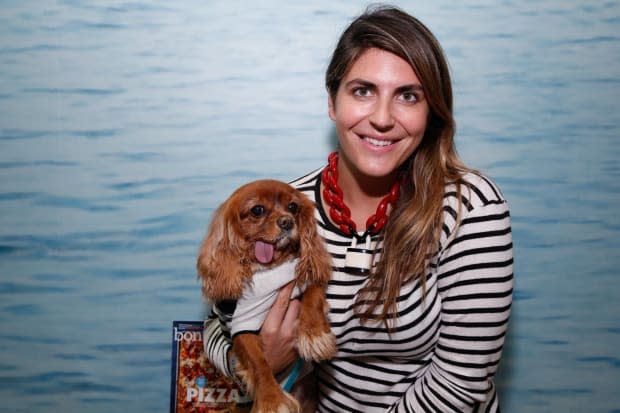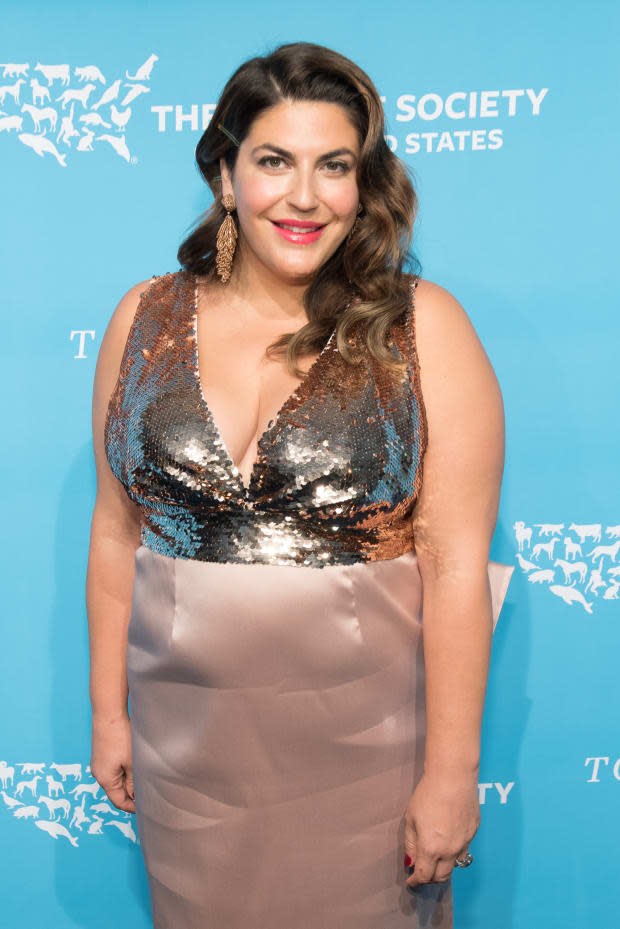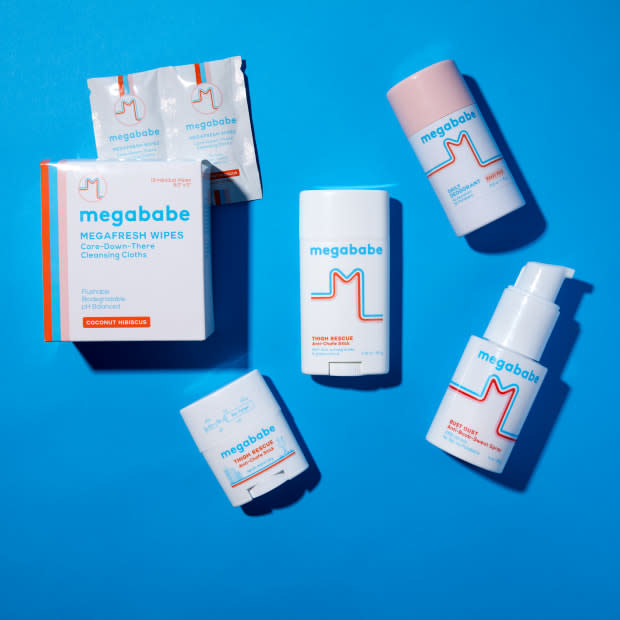How Katie Sturino Went from Working in PR to Becoming an Influencer-Entrepreneur
The founder of Megababe and face of "The 12ish Style" talks about achieving balance and finding space in the market.

In our long-running series, "How I'm Making It," we talk to people making a living in the fashion industry about how they broke in and found success.
Katie Sturino has had an extremely busy summer: There was a June wedding, followed by an Italian honeymoon; the launch of a size-inclusive collaboration with Stitch Fix; running "The 12ish Style," her blog dedicated to plus-size fashion where she launched the #MakeMySize movement; and several big things in the works at Megababe, the beauty line she founded just a couple of years ago. It's no wonder she's a hard woman to pin down.
Though she's a social media superstar now, Sturino got her start behind the scenes working in PR, landing gigs at high-fashion companies like Dolce & Gabbana and a small boutique agency. But it wasn't an easy start.
"I really hated that environment; I found fashion people to be very humorless and very rude, and that was really hard for me," she admits. "I also think I felt out of place because of my size, a lot of the time; that's mental and I was not in a place where I was comfortable. I was always the biggest person in the room; I couldn't fit into the samples at Dolce. I always felt uncomfortable, I think."
Then Sturino had a few breakthroughs and started her own PR firm at the tender age of 25. Her entrepreneurial spirit lead her to building a successful influencer career for her dog, Toast, which is how she discovered she could use social media to make changes of her own.
We caught up with Sturino to chat about everything from the challenges of launching your own brand to the power of discovering self-confidence. Read on for the highlights.
What first interested you in fashion?
I just really liked clothes and I liked the way that you could transform yourself or the way that clothes conveyed a message about you. I think I've witnessed that mostly in movie characters and not necessarily in my real life, because I'm from Milwaukee, Wisconsin and it was not necessarily the fashion capital of the world that I knew New York was. I was like, well, I'm interested in this, this isn't here, so let me go there.
What were your first steps getting into the industry?
I started applying for internships at any place I could find — Ralph Lauren, Chanel, Neiman Marcus. I was at University of Wisconsin and had no connections, and the only person to write me back out of everyone I applied to was Chanel and they asked for further information from me. It was probably a form email letter, but I got someone's email from it, so I emailed her every three days like, "Just checking back in on the status of my internship application."
She said that they were holding internship interviews in the next two weeks, so I flew to New York on my own dime. I did my interview with Chanel and she said that she had no reason to give me the internship — because I have no experience, I have no knowledge — but I was the most persistent person she'd ever met, so she gave me the internship and then I ended up coming back a second summer to work for them. When I graduated, I thought I was going to be like, "Oh, now I work at Chanel." But there were no jobs available. I didn't understand that that's how it worked.
I ended up working for Dolce & Gabbana in their PR department, in their closet doing PR clips. One day the marketing manager called my desk, thinking she was calling the other person, and was like, "I don't think we have a need for Katie anymore. I think it's time to let her go." And then I was like, "...okay, it's me." So I got a job at a small agency and that's how I discovered that I liked agencies, because you got to work with different clients and I liked working directly with these small businesses and watching them grow. Then I worked for Bobbi Brown, on a book called "Living Beauty"; I was the the project manager, and I realized I really did like PR work, so I decided to start setting up the groundwork to start setting up my own agency.
Related Articles
How Lynn Tesoro Followed Her Gut and Built Her Dream PR Firm
How Eva Chen Went From Pre-Med Student to Director of Fashion Partnerships at Instagram
At Stitch Fix, the Key to Improving the Plus-Size Market Is in the Data
I cobbled together two or three clients and after eight months at Bobbi, the book was done and I was like, I'm going to go do my stuff. I was faking it until I make it, acting like a full adult. I was so young to start my own agency; I was 25. If someone told me they were trying to start an agency right now at 25, I'd be like, "Go to school. Go learn something." But I don't think I was very impressed with the people I had seen above me.
So I had my own agency for 10 years and I was [called] Tinder when Tinder launched. I changed my name after a couple of years; I ended up selling my website to Tinder because I was getting so many inquiries from media actually, and from people who couldn't find dates, so then I just changed it back to Katie Sturino PR. I wanted something creative to play with, so I started dressing my dog Toast up in "who wore it better" outfits.
I felt like a publicist; I thought, okay, we're near Oscar season, I'll try to dress her up in an Oscar look. I had an outfit made from a woman on Craigslist, and I sent it around like a press release. Everyone was like, "What the fuck is this?" But Leandra [Medine] from Man Repeller wrote back and was like, "I love this, I'd love to do one with her," so then we did a "who wore it better" with Leandra and that was great. Eva Chen saw that and was like, "This is hilarious. I want to do a video," so we did a funny comedy when Eva was at Lucky. Then [Toast] became a fashion dog; she modeled for Karen Walker, she got married on "Real Housewives" and she wrote a book — she had the whole thing.
That was really incredible, and I started to understand and see the power of influence and the power of social media, and that that could be your career.

What made you want to launch The 12ish Style?
Man Repeller did a style feature on me and that was the first time I had ever thought of myself as someone who could go in front of the camera, truly. Because as someone who's behind the scenes, you never think of yourself like that. After seeing that feature and reading comments from women who are like, "Oh my God, I've never seen my body type on a blog or on a social media site or like in anything" — women seeing themselves, seeing their body type.
I felt the same way and I was like, who's doing this? I'll do it. I'm always telling people where I'm buying stuff and I'm always trying to give tips and hacks and fashion advice. I named it "The 12ish" originally because I was like a fluctuating person in a bigger space. So sometimes I was a 12, sometimes 14, sometimes 16; I think a lot of women in that size range slide up and down.
What was the adjustment period like for you going from being a behind-the-scenes person?
If you look at my first six months of posts, it was very awkward. I was trying to figure out what people wanted to hear and what I wanted to say, and at the time, I was still in a relationship that wasn't necessarily a supportive launchpad for this, so I think I felt self-conscious a lot. I just didn't feel very good about it, so it took me a while to find my footing.
Was there a moment where you felt like, 'this is really connecting with people' or taking off?
I would say almost immediately I knew it was connecting with people. It took me awhile for it to come full circle for myself, because I was uncomfortable. But people right away — media people, women I talked to, friends — everyone got it right away.
How has that evolved since you started?
For one, it's been a journey of my own self acceptance. I think it went from a place for me to help people shop to a place where people of all sizes can come and find inspiration for being more accepting of their body — or at least not having their body be the main thing, the obsessive thing, the indicator of your mood and that kind of thing.
Where did #MakeMySize come from?
#MakeMySize came from general outrage, and me shopping and not being able to buy anything because I had gained a lot of weight and I was no longer in the 12, 14 zone, but more in that 16, 18 zone. Basically, I realized that outside of the 12 and 14 range — that once you're a 16 and 18 — there's nothing to wear. If you're trying to participate in the fashion conversation or wear something that isn't made of a flammable nine-dollar material, you cannot get dressed. What's so funny is that high, high-end brands, they will always make custom clothes for women. So it's like the way low or the super high end, and there's nothing in between.
What's the reaction been on that?
It's been amazing; I think it's really empowering for people. What I've seen, which is really cool, is that women are able to take back that experience in the fitting room. It's shifting the blame off of, like, "If I didn't have frozen yogurt last night, then maybe I would fit into these pants" and more being like, "Why is this fucking size 10 like a size six?" or "Why is this the biggest size you offer in the store?" or "Why do you think that my body shape is so freakishly large that I can't put on a single thing in your shop?"
It's shifting the blame off of you to the brands and thinking more about why are the size zeros and twos always out on the floor? Why do I have to order online? Why doesn't the double zero order online? There's no shade to the double zero — that's not what this is. It's more that that's the party line with fashion, that the small sizes are catered to, the larger sizes are pushed to the back.
Where did the idea for Megababe came from?
It was just after another New York City summer; I basically was so tired of using a men's product, and I was always talking to my followers about "What are you using? What are your hacks? What makes you comfortable in the summer?" When I looked at the market, I was like, "Why is everything for a man, an athlete, or something so embarrassing, so cheesy, that I don't want to touch it?" So I was like, "Let's do this. Let's make something better that's effective, more effective and safe than using deodorant in between your legs."
I talked to my sister, I talked to my best friend; we had, again, no experience in the beauty space or the product space. We just figured it out and had no idea if anyone was going to want it or buy it or think it was interesting, and I'm glad that they did.
What was the experience of launching a brand?
It's really scary, especially because I find a lot with media — fashion writers tend to be on the thinner side, and not that thigh chafe is a size thing, but fashion celebrates a thigh gap. They're not talking about thigh chafe. The learning curve and the explanation with media was really hard, because it was like "Thigh what? What's that?" That conversation was hard but the boob sweat Bust Dust spray was an easier thing to explain to people because they were like, "Oh yeah, I get sweaty."
I still deal with that all the time, where I either get a blank face or I get someone who's like, "I have that too," and I'm like, "We don't have to whisper about it." I just want it to be like: I put my eyeliner on, I put my deodorant on, I put my Megababe Thigh Rescue on. I don't want it to be something that is your secret thing anymore, because keeping it in the closet like that makes it feel more shameful and it makes it feel like "I'm the only one who has this."

Were you surprised that it almost instantly had a waitlist?
I was very surprised, because I had heard from so many different people — beauty people, factory people, friends, family — that I was making a product that no one needed and that it was so niche. It was really hard to look at people who you care about and have them say these things, and I'm really, really happy that they were wrong.
How do you decide to add new product?
The products we have coming up, some of them are from my brain and some of them are because that's what the people asked for. I try to add things that I use; I try to stay in the lane of comfort. You could argue that I make products for the dirty girl, who doesn't like to shower that much and is super sweaty because that's how I think of myself. Like our Rosy Pits Deodorant Wipes — that's just something that I would use when I need a refresh because I'm running in between things and I need to start over. I like the Bust Dust because it's hands free but a lot of people have not fallen in love with the application process, so I made Body Dust, because people wanted a different alternative for the powder.
The deodorant was a total fluke, because I was like, "Who's going to buy a deodorant from us? There's all these cool deodorants on the market, why would you even look at ours?" But the fact is that the natural deodorants that are out there do not work for me. I got bad rashes from the baking soda; I have learned that deodorant is a very personal thing and I'm not offended if our deodorant doesn't work for someone — but we had a 13,000 person wait list, so it works for a lot of people, which is great.
How are you balancing your time between Megababe and blogging?
They're separate, but the spirit or the soul of it is similar, so it all feels like the same mission of helping women feel more comfortable.
I work with my sister, my best friend and my brother, and they all help out with logistics. For the first two years we shipped out of my parent's garage, so the Ulta truck would back up a giant semi into my parents' house. And my parents were packing each order. We are still extremely scrappy because we're still self-owned, self-funded and we have not taken on investment, so we're really careful with our dollars, we're very conservative and we work a lot. That doesn't mean we have no one helping us; we have a PR agency, we have someone who manages our relationship with Target, but we don't have an office and a full-time employee. In fact, I'm based in New York, my sister's based in Chicago, my best friend is in San Francisco — we're on three different time zones. It's a fucking nightmare.
But, knock on wood, we're doing well; we're expanding into most Targets starting this fall and we're adding products. We are already in every Ulta and expanding there; we went from the discovery bin, to now we have a shelf. That's my role, is to keep moving forward and keep wanting more and more and more, and my sister and Kate's role are to balance me. So I'm like, "We need you to be everywhere, international, let's go," and they're like, "Chill."

How have you seen social media change things?
It's given people a platform to launch product, which, it can be good and bad, right? Because the world doesn't need all the products that we're launching. Now, that being said, I do have a company that makes product, but as I've heard from retailers that see hundreds of new product pictures a day, we are in a white space, so I feel comfortable and I feel good about doing something new, because we have launched into a women's comfort space that did not exist.
What challenges do you still face?
Well the Instagram front is, what if it changes? What if the platform changes? People have their entire careers, stores, their lives around this platform and it could change in a second. That's really scary. And I'm not burnt out with Instagram at all.
With Megababe, we have a lot of challenges ahead of us and we're so lucky to have had success, but we have so far to go in the range of what success looks like. This is not something that happens very easily, even though it feels like it happens really easily: I would like someone to acquire us, because at a certain level it just gets more complicated.
What is your ultimate goal for yourself?
The problem with me is that I think I might be what they call a "serial entrepreneur," because I love businesses. While I would definitely retire to a beach, I would be working from there; that would be my dream, is to be splitting time between places. I would love to be the face of Megababe; I don't want to stop doing anything I'm doing, I just would like to spend more time on a beach.
This interview has been edited and condensed for clarity.
Want the latest fashion industry news first? Sign up for our daily newsletter.
